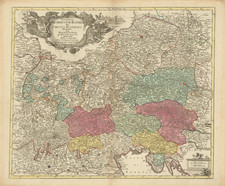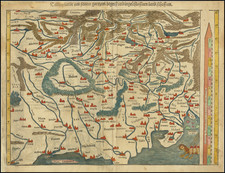An attractive and very scarce map of early 19th century Vienna. Titled in German and in French, it follows closely after von Grimm's seminal 1797 map of the city. This version orients the map northwards and shows a few new developments, especially along the city's outskirts.
The title of the map translates to "Plan of the Imperial-Royal Capital and Residence of Vienna with its suburbs," identical to von Grimm's title save for not mentioning house numbers. Thirty-eight neighborhoods and parts of the city are denoted along the bottom of the map, and over a hundred streets, plazas, buildings, and more are labeled. This is clearly an intricate map of the city.
Maps of Vienna in this era are prized as they provide a rare insight into the layout of the city as it was when it was a true cultural capital of Europe. The city was soon to be restructured, as discussed below, meaning that the city of Mozart, Salieri, Haydn and their contemporaries was very different than that of Freud, Wagner, Adler, Zweig, and others who came later.
In the map, the city retains its early layout with two sets of ramparts, one around the outer perimeter of the city and one around the Innere Stadt. The two cities would not be joined politically or spatially until the mid-19th century when the ramparts were dismantled and replaced by the Ringstrasse. This ring road, attractive in its own right, is commonly used as a prime example of "historicism," or how historical context defines the use of space and vice verse. The early ramparts made for a crowded and separated city which lead to its medieval characteristics, while the Ringstrasse allowed for a more connected and inclusive use of space.
Tranquillo Mollo was an Italian-born publisher who moved to Vienna by 1792. He published until 1832 when he passed the company to his children. He was best known for publishing works of music, including publishing for Ludwig van Beethoven, but he also made maps of the world. The best estimate for dating of this map places it before 1804 when Mollo changed his signature to T. Mollo. It appears that only maps prior to this were signed with his full name, but his tendency to leave his maps undated complicates matters.










![[Austria] Partie Septentrionale Du Cercle D'Autriche, qui comprend L'Archiduche D Autrice divise en ses huit Quariers et La Haute Partie du Duche de Stirie . . .](https://storage.googleapis.com/raremaps/img/small/41724.jpg)
![[ Salzburg Lungau - Tamsweg District -- Road and Trekking Map for Southern Salzburg ]](https://storage.googleapis.com/raremaps/img/small/100458.jpg)

![(Austria) Charte der Österreichischen Monarchie, nach den letzten Friedensschlüssen berichtigt. [Map of the Austrian Monarchy, corrected according to the latest peace treaties.]](https://storage.googleapis.com/raremaps/img/small/102892.jpg)
![[ Austria ] Arciducato d' Austria che compone parte Circulo de Medo: nome diviso . . . 1684](https://storage.googleapis.com/raremaps/img/small/60212.jpg)